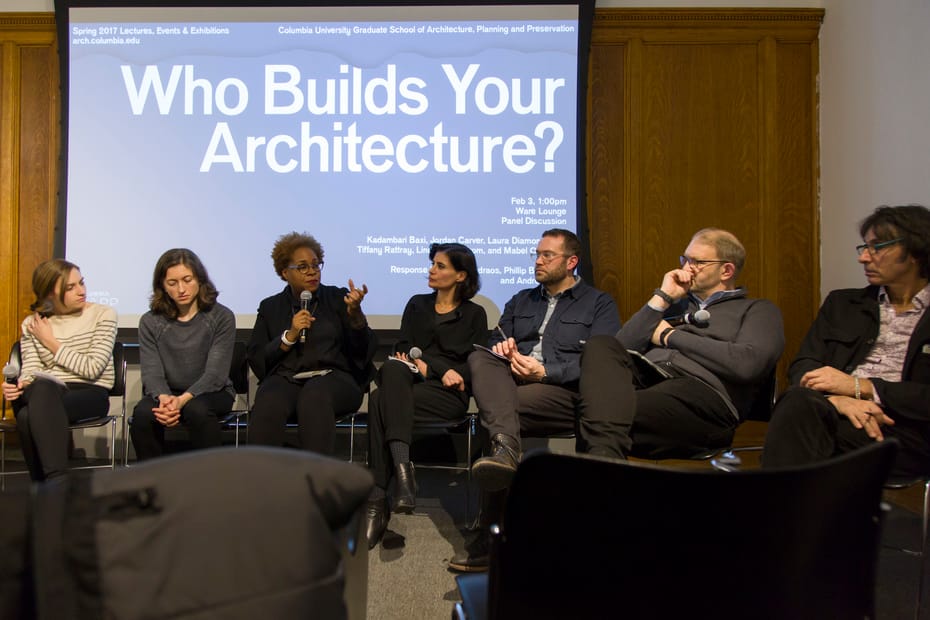
Architecture and Labor, Comprehensive Review of Who Builds your Architecture?: Critical Field Guide
The critical field guide: WHO BUILDS YOUR ARCHITECTURE conceived by a group of the same name, abbreviated as WBYA, serves its role in the curriculum as a relevant vector of both contemporary practical knowledge and theoretical frameworks. However, it should be noted that due to its lack of praxis aside from the proposed signage of the group’s pledge-which the knowledge in the field guide seems to be predicated upon-other texts should be supplemented in the curriculum as well, with the intent to make up for WBYA’s shortcomings. Rather than tunnel-visioning on certain issues of the labor within architecture, WBYA's broad contemporary perspective aligns with the international qualities and variables of the systems that move through architecture and the international labor used to perceive it. Conversely, this broad seeming neo-historical perspective on the contemporary systems of architecture and labor in place have disconnected WBYA from its potential practical applicability for an architect or any other actor within this proposed system. Though in both historical context and in the curriculum, WBYA will be of its own significance, purveying the very reality and role of architecture and the architect within this unveiled system.
(WBYA?) asks architects and allied fields to better understand how the production of buildings connects their design and consulting practices to the workers who ultimately build them-WBYA? Critical Field Guide introduces key terms, questions, case-studies, and proposals that locate architecture within the complex transnational networks of contemporary building construction and connects it to the problems faced by construction workers who exist in the same system.
WBYA introduces itself as a tool through which architects are to ask themselves questions, although not done in a sort of socratic method but in a way that goes to show that it leaves it up to the architects on how to approach the given situation. The process lifts the veil that misconstrues and shrouds the fact that architects and the laborers that construct their architecture exist within only perceived alienated systems. WBYA goes a step further in proposing that with the knowledge of the reality of this interconnected system, the architect’s role in the system has changed. Immigrant workers are fundamentally exploited by the systems of capitalism that employ and facilitate architecture and architects, and in turn, architecture facilitates the system. Throughout history there has been a growing dissonance between the laborer and the labor produced, inherently made possible with the division of labor. This analogous framing proposed by WBYA is integral in exploring and understanding WBYA’s role and its approaches to the contemporary systems of labor and architecture.
In a historical context, very often architecture has been seen as the architect’s or a nation’s work rather than the real conditions of the world at the expense of the laborer, and this has only been growing with the increase of late-stage neoliberal capitalism and the industrial driven division of labor. WBYA seeks to quell this dissonance, as it is proposed that the ignorance of the architect and leading actors within the system is the very driver of this perpetual dissonance, and the exploitation of the worker. However, WBYA prescribes this dissonance between the intellectual labor, laborer, labor itself, and its conception, to be at most facilitated by said current economic systems, but not as a direct ailment of it. Instead, it frames the lack of clarity of the situation and mechanics of labor to be the main ‘curse’, and WBYA as the cure. WBYA does this by piercing the veil with various pieces of practical evidence strewn about in its field guide, but there is only a small segment near the end of what in a historical context should be its leading question for any contemporarily defined and scoped book and in this case guide: the question of how?
WBYA’s shortcomings are entirely predicated on its substantial lack of a praxis. WBYA introduces its ideology with its simple alignment to the unveiled means of the operation of the labor of architecture, increasing the ethical obligation of the role of the architect with this increased level of knowledge, however, lacks the praxis aside from a pledge to enact the actions necessary to fulfill this proposed obligation. It does not substantiate a real praxis, and cannot even be considered an exploration of it, despite its contemporary nature. However, WBYA still serves its purpose in this cirricumulative context, even if it is unaware of its shortcomings to fill its own historical role. WBYA may simply show that architects and architecture are just symptoms of a systemic problem. With readings already in the curriculum such as ‘Form Follows Finance’ and explorations of Chinese labor practices, students may come to the understanding of how the systems of architecture and labor come into regulation, the role of the architect within this system, and how we may move forward both in contemporary and historical frameworks.
WBYA?. Who Builds Your Architecture?: A Critical Field Guide. Who Builds Organization, 2017
Ruth Wilson Gilmore. “Abolition Geography.” in Essays Towards Liberation, London and Brooklyn, NY: Verso, 2022.
Carol Willis. “Vernaculars of Capitalism.” in Form Follows Finance: Skyscrapers and Skylines in New York and Chicago, Princeton Architectural Press, 1995.
Karl Marx and Frederick Engells. “Ruling Class and Ruling Ideas.” in The German Ideology, edited by C.J. Arthur, New York International Publishers, 1970.
David Graeber. “Communism.” in The Human Economy, edited by Keith Hart, Jean-Louis Laville, and Antonio David Cattani, Melville House, 2011.
Alison Rose Reed. “Against Conspiracies of the Inevitable; or, A Review of Abolition Geography” The Avery Review 61, (April 2023): The Avery Review | Against Conspiracies of the Inevitable; or, A Review of <i>Abolition Geography</i>
Kevin Block. “Autonomy Online: A Review Of edX’s “The Architectural Imagination” The Avery Review 26, (October 2017): The Avery Review | Autonomy Online: A Review of edX’s “The Architectural Imagination”
Davide Deriu. “The City of Collective Melancholy: Revisiting Pamuk’s Istanbul” Taylor & Francis Online 8, no. 1 (May 2020) 69-93. Full article: The City of Collective Melancholy: Revisiting Pamuk’s Istanbul (tandfonline.com)
This was citated originally in the Chicago style. For footnotes, see original:
